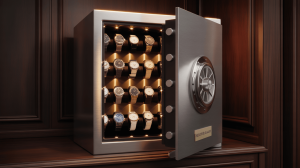A home safe with a built-in watch winder does two jobs. It locks away valuables behind thick steel. It also keeps automatic watches wound and accurate. Instead of separate devices, this unit combines security and convenience. Every morning, you find watches ready to wear. Jewelry and documents stay organized and safe. Before you decide, learn what features matter and why some collectors swear by this hybrid solution.
1. Defining a Home Safe with Watch Winder
A home safe with watch winder looks like a cabinet. It has steel walls and a reinforced door. Inside, padded drawers hold jewelry and small valuables. Adjacent to those drawers are rotating modules for automatic watches. These modules mimic wrist movement at set turns-per-day (TPD). The safe locks using multi-point bolts and a secure lock. You get one unit that organizes, secures, and maintains watches.
2. Core Functions and Benefits
This hybrid safe serves three main purposes. First, it secures jewelry, documents, and small electronics. Second, it preserves automatic watches by winding them. Third, it organizes items so you can find them quickly. No more tangled necklaces or dead watch batteries. The safe’s interior keeps items in digestible sections. A dedicated compartment for paperwork prevents clutter. Together, these functions streamline your daily routine.
3. Security Features
Home safes must resist forced entry. Look for UL RSC or ETL burglary certifications. These ratings mean the safe withstands pry bars and drills. Fireboard insulation and intumescent gaskets achieve UL 72 Class 350 fire ratings. They protect contents for at least 30 minutes at 1,200 °F. Biometric scanners or electronic keypads offer personalized access. Hidden hinges and multi-point steel bolts add defense. A bolt-down kit anchors the unit to floor joists or wall studs.
| Security Feature | Specification | Benefit |
|---|---|---|
| Burglary Rating | UL RSC / ETL certified | Resists forced entry |
| Fire Rating | UL 72 Class 350 | 30 min protection at 1,200 °F |
| Lock Type | Biometric / Electronic | Personalized, tamper-resistant |
4. Watch Winding Requirements
Automatic watches need movement to stay wound. Built-in modules spin watches at precise TPD settings. Entry-level units offer 650–1,200 TPD. Premium models reach 2,000 TPD or more. Direction control—clockwise, counterclockwise, or bi-directional—matches manufacturer specs. Pause intervals prevent over-winding. Look for high-quality motors under 25 dB for quiet operation. Rubber-dampened mounts reduce vibration. Proper winding preserves lubricant distribution and extends service intervals.
5. Interior Layout and Capacity
Successful organization hinges on a thoughtful layout. Padded drawers keep rings and earrings separate. Velvet-lined ring rolls hold bands upright. Necklace hooks hang chains to prevent tangles. Leather watch pillows cradle timepieces securely. Some models include hidden lower drawers for documents or spare watch straps. Modular trays let you expand capacity as your collection grows. Choose a safe that accommodates your current items and any future additions.
6. Build Quality and Materials
The safe’s durability depends on construction materials. High-end models use 12–14 gauge steel for walls and doors. Weld seams should be continuous, with no visible gaps. Powder-coat finishes resist scratches and corrosion. Hardware—hinges, bolts, and locks—should use corrosion-resistant alloys. Interior linings of velvet, suede, or leather protect valuables from surface damage. Inspect insulation materials; composite fireboard or ceramic insulation delivers consistent fire protection.
| Material Aspect | Specification | Advantage |
|---|---|---|
| Steel Gauge | 12–14 gauge | High resistance to attacks |
| Finish | Powder-coat or veneer wrap | Scratch and corrosion resistance |
| Interior Lining | Velvet / Suede / Leather | Protects against surface damage |
7. Climate and Humidity Control
Humidity can harm leather straps and precious metals. IP54-rated door seals block dust and moisture. Passive desiccant chambers absorb residual moisture. Some safes include active dehumidifiers to maintain 40–50 % relative humidity. Digital hygrometers display current levels. A stable micro-environment preserves both watch movements and jewelry finishes. This protection reduces cleaning and repair needs over time.
8. Smart Connectivity Features
Modern safes often include Bluetooth or Wi-Fi modules. Receive real-time alerts for tamper events or door openings. Get low-battery and humidity warnings sent to your phone. A dedicated app allows remote lock/unlock and winding schedule adjustments. Audit logs record every access event for full accountability. Enterprise-grade encryption ensures your data remains secure. Connectivity adds convenience and peace of mind, especially when traveling.
9. Power Supply and Backup Options
Built-in winders and electronic locks require constant power. Most safes include an AC adapter for daily use. Rechargeable lithium-ion batteries serve as backup during outages. Low-battery LED indicators and app notifications warn before shutdown. A hidden mechanical override key or combination dial provides manual access if electronics fail. This layered approach prevents lockouts and maintains winding functions during power disruptions.
| Power Option | Description | Benefit |
|---|---|---|
| AC Adapter | Primary power source | Continuous operation |
| Rechargeable Battery | Backup for wiring and locks | Prevents lockouts during outages |
| Mechanical Override | Hidden key or dial | Manual access if electronics fail |
10. Installation and Anchoring Recommendations
Proper installation maximizes security and stability. First, locate floor joists or wall studs with a stud finder. Use heavy-duty lag or sleeve anchors rated for the safe’s loaded weight. Level the unit before full tightening to prevent door binding. Conceal anchor heads beneath interior liners or cabinetry trim for a clean look. Professional installation is recommended, especially for larger or heavier safes, to ensure correct anchoring and optimal performance.
11. Noise and Vibration Levels
A safe that hums or rattles can be disruptive. Premium watch winders use precision motors that operate under 25 dB for whisper-quiet performance. Rubber-dampened motor mounts isolate vibration. Soft-close hinges prevent slamming noises. Silent locking bolts reduce ticking and clicking sounds. Even in a quiet bedroom or home office, the unit runs discreetly without disturbing sleep or daily tasks.
12. Maintenance and Care Practices
Routine maintenance prolongs both the safe’s life and your valuables’ condition. Dust exterior surfaces weekly with a microfiber cloth. Run empty winding cycles monthly to keep motors healthy. Test locks and electronics quarterly for smooth operation. Replace desiccant packs every 6–12 months, based on local humidity readings. Swap backup batteries annually. Lubricate mechanical locks according to manufacturer guidelines. Maintain a service log to track dates, notes, and any issues that arise.
| Maintenance Task | Frequency | Tool / Tip |
|---|---|---|
| Dust Exterior | Weekly | Use a soft microfiber cloth |
| Test Locks/Winders | Quarterly | Record performance in a log |
| Replace Desiccants | 6–12 months | Rotate packs for maximum effectiveness |
13. Cost vs. Value Analysis
Home safes with watch winders range from $1,500 to $10,000+. Entry-level models start at $1,500 for 2–4 winding bays and basic jewelry drawers. Mid-range options ($2,500–$5,000) add climate control, LED lighting, and smart connectivity. Premium safes ($5,000+) feature custom veneers, biometric locks, and full IoT integration. Insurance discounts for certified fire and burglary protection can offset initial costs. Over time, reduced watch servicing and fewer jewelry repairs contribute to overall savings.
| Tier | Price Range | Core Features |
|---|---|---|
| Entry-Level | $1,500–$2,500 | 2–4 winders, basic jewelry drawers |
| Mid-Range | $2,500–$5,000 | Climate control, LED lighting, app |
| Premium | $5,000+ | Custom finishes, biometric lock |
14. Alternatives to a Dual-Function Safe
Separate devices may suffice if you have budget or space constraints. A standalone watch winder costs $200–$500 for a 2-bay unit. A dedicated jewelry safe runs $300–$800 for moderate capacity. However, separate units take more room and require multiple keys or codes. They usually lack unified security certification, which may reduce insurance benefits. A hybrid safe streamlines security and convenience in one cohesive package.
15. Do You Really Need One?
If you own multiple automatic watches and valuable jewelry, a hybrid safe offers real benefits. You save time by eliminating manual winding. Your collection remains organized and protected. Combined security and convenience can justify the investment. If you only have a few pieces or limited space, a standalone safe or winder may suffice. Evaluate your collection size, security needs, and budget. Ultimately, choose the solution that makes your daily routine simpler and your valuables safer.
FAQ
Q1: Can I store both quartz and automatic watches?
Yes. Quartz watches fit into static trays, while automatic watches sit in winding modules.
Q2: How often should I replace desiccant packs?
Replace desiccant packs every 6–12 months, depending on your local humidity, to maintain 40–50 % RH.
Q3: Are smart connectivity features secure?
Top models use AES encryption and require strong, unique passwords for remote access.
Q4: Do these safes require professional installation?
Professional installation is recommended for larger or built-in safes to ensure proper anchoring and stability.
Q5: Can I expand the safe’s capacity later?
Many models offer modular trays and drawer kits, allowing you to add winding bays or jewelry compartments over time.







